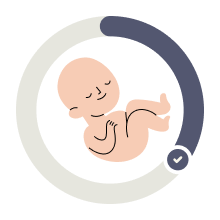When reaching the 35-week pregnancy, certain expectant mothers may feel overwhelmed by the remaining tasks before their baby arrives, while others are eagerly anticipating the baby’s arrival.
However, it’s important not to stress too much because the baby will come when they’re ready and won’t be concerned if every tiny detail on your checklist is completed.
As long as you have a secure sleeping arrangement for the baby, an ample supply of diapers, and an infant car seat for the journey home, you’ve already met several fundamental requirements for the baby’s well-being.
Pregnancy Week 35 Quick Facts
- At 35 weeks, you’re eight months and three week pregnant
- You have 5 weeks until your due time “Calculate Your Due Date”
- This is your third trimester
Your Unborn Baby’s Size at 35 Weeks
How Big is a Baby?
By the 35th week of pregnancy, the size of the baby is comparable to that of a pineapple, measuring roughly 18.2 inches from head to heel. Although the baby won’t increase much in length from this point onwards, they will continue to gain weight. At this stage, the fetus weighs approximately 5.3 pounds and will accumulate a pound or more of baby fat prior to their delivery.
Pregnancy Symptoms Week 35
As you approach the end of your pregnancy, you may be grappling with a range of third trimester symptoms, including Braxton Hicks contractions, fatigue, swelling, and frequent urination. Additionally, you may be struggling with headaches and sleep disturbances in these final weeks.
Headaches all the time?
Although headaches can occur at any point during pregnancy, they are more prevalent during the first and last trimesters. Early-pregnancy headaches are often linked to increased blood volume and hormone levels, while later-in-pregnancy headaches are frequently due to worsening posture, sleep difficulties, and stress.
Facing a sleeping issue?
Sleeping problems are also prevalent during pregnancy, with approximately 78% of people experiencing them. Finding a comfortable position, night sweats, heartburn, frequent urination, and anxiety/excitement about childbirth are some of the factors that can lead to sleep disturbances. According to studies, about 98% of people wake up during the night due to these issues.
Getting adequate sleep can be challenging during the final weeks of pregnancy and the first few weeks postpartum, especially when caring for a newborn. Although achieving an uninterrupted full night of sleep may not be possible, the following tips can help you get as much sleep as possible:
- Stay hydrated throughout the day, but limit your fluid intake in the evening to reduce nighttime bathroom trips.
- Avoid foods that may cause heartburn and refrain from eating too close to bedtime.
- Incorporate safe exercises into your daily routine.
- If you feel the need to nap, do so earlier in the day.
- Ensure that your sleeping environment is comfortable by adjusting the temperature to a cooler setting, as recommended by experts. Layer bed covers for easy addition and removal.
- Use bed and body pillows to find a comfortable side-sleeping position.
- Avoid electronic devices and television before bedtime, and opt for reading instead.
- Establish a consistent sleep schedule by going to bed and waking up at the same time each day.
- Try relaxation techniques or meditation in the evening to prepare for sleep or return to sleep after waking up.
- Speak with your doctor about safe medication options if needed.
Prenatal Tests and Doctor’s Appointments
You can expect to have a prenatal visit next week when you reach 36 weeks. Following this appointment, you will begin having weekly visits with your healthcare provider until your delivery.
Between the upcoming week and week 38, you will undergo a screening test for a bacteria known as Group B strep (GBS), which is present in approximately 1 in 4 pregnant women and is commonly found in the vagina.
In the event that there are any concerns regarding your health or your baby’s well-being, your doctor may recommend additional tests, including:
- Contraction stress test
- Fetal non-stress test (NST)
- Biophysical profile
- Modified biophysical profile
- Doppler of umbilical artery
Special Considerations
Sign of labor
An additional sign of labor to be aware of is the presence of thick vaginal discharge that may be pink or slightly tinged with blood. This indicates the beginning of the release of the mucus plug. The mucus plug is a clump of tissue that has been preventing bacteria from entering the uterus by blocking the cervical opening during pregnancy. However, losing the mucus plug does not necessarily mean that labor will start immediately. Some women may lose their mucus plug up to two weeks prior to the onset of active labor.
Preparing Your Pets for the Arrival of Your Baby
If you have a dog or cat, it’s important to assist them in adjusting to the presence of your new baby. One strategy is to bring a fresh baby blanket to the hospital. After wrapping your baby in it for a few hours, the blanket will carry their scent. Later, have your partner bring the blanket home, allowing your dog to become familiar with the baby’s scent before your return from the hospital. Ensuring that your pets are up-to-date with vaccinations is also crucial. Additionally, if your pet has developed any undesirable behaviors such as biting or pouncing, this is an opportune time to address and correct these habits prior to the baby’s arrival.
Developmental Milestones
Brain Growth
Although babies may appear fully developed at 35 weeks, there is ongoing growth occurring within their brains that remains hidden. The final stages of pregnancy mark a period of rapid brain development for your baby. Remarkably, during the last 4 to 5 weeks before reaching full term, the weight of the baby’s brain increases by one-third.
Body Weight
Furthermore, your baby is steadily gaining weight, adding approximately 8 ounces (half a pound) to their overall weight each week. As each ounce accumulates, more fat accumulates beneath the baby’s skin, resulting in smoother, less wrinkled skin.
Amniotic Fluid
Approximately one quart of amniotic fluid serves as a cushioning and protective barrier for your baby. Throughout pregnancy, its volume gradually increases until around 36 weeks, after which it gradually decreases until delivery.
Elimination
At this stage, your baby’s kidneys have reached full development and have been producing urine since you were 13 weeks pregnant. Interestingly, your baby actually pees into the amniotic fluid. Additionally, your baby’s first bowel movement, known as meconium, is accumulating in their intestines.
Sleep Patterns
Your baby now exhibits distinguishable sleep patterns. You may begin to identify these cycles, as you will likely feel more movements when your baby is awake and fewer movements when they are asleep.
Survival Outside the Womb
At 35 weeks, babies are considered “late preterm” or near term, indicating that they are almost prepared for birth. Although they may require some assistance with oxygen immediately after delivery, their chances of survival surpass 99%, and they face a significantly lower risk of long-term disabilities associated with prematurity.





